Understanding Evolution - The Basics
This entry is part of a collection on Understanding Evolution. For other entries in this collection, follow that link.
I discuss evolution enough on this blog that I figured I ought to do a post covering the basics. Just what is evolution, and how does it work? I'm going to try to focus mainly on describing what evolution is, but since there are so many misconceptions out there, a little bit of this post is going to be clarifying what evolution isn't. I'll admit up front that this explanation is a little animal-centric, even though evolution occurs in all types of life.
Defining Evolution and Understanding DNA
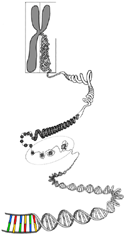 At the most basic, evolution is change in a population over time. But to understand that change, first you need to understand where it comes from.
At the most basic, evolution is change in a population over time. But to understand that change, first you need to understand where it comes from.
In a way, our cells and bodies are run by our DNA and genes. DNA is a long, chain-like chemical in almost all of our cells. Along the length of that chain are special sections called genes, that act like templates for making various chemicals that our cells will use. You can think of our DNA and genes somewhat like a set of instructions for how the cells will work. If A happens, do B. If C happens, do D. And on and on. It's all of these instructions interacting together that make our cells work the way they do, and then all of our cells interacting together to make our bodies work the way they do. This even affects the way we grow up and mature. There may be some genes that work together to tell certain cells to become muscles, and other cells to grow bones, and other cells to become nerves.
By and large, whatever DNA we're born with is the DNA we'll have our whole lives. But, sometimes our cells make mistakes in copying the DNA. These mistakes are called mutations, and can change the instructions of our DNA. Mutations can be harmful, beneficial, or not even really do all that much and be neutral. Some of the most harmful mutations that can occur in our bodies lead to cancer. But most of those mutations don't affect evolution, because they only affect their owner's body, not their children. The only mutations that affect evolution are the ones that can be passed on to the next generation, the ones that occur in the specific cells that are going to come together to make a new baby - eggs and sperm. If mutations happen to either eggs or sperm, then the babies will have a slightly different set of instructions than their parents.
None of us pick and choose our DNA, or how we want it to change. We can't will ourselves to be taller, or for our children to be taller. And we can't change our DNA through actions. For example, when we go to the gym to work out, we'll get better cardiovascular health and bigger muscles, but we won't change any of our DNA having to do with muscles or health, and we certainly won't change any of the DNA in our eggs or sperm that way. So, no matter how much we work out, our children are going to get basically the same heart and muscle controlling DNA as we have. They'll start off with the same potential as we did, and if they want to be healthy and get big muscles, they'll have to go to the gym and do the work themselves.
When these changes to our DNA happen, they simply happen by chance. Like I already said, you can't pick the mutations. Your children can't pick the mutations. There's no invisible hand controlling the mutations. They're simply mistakes made at the chemical level, when cells don't quite make a perfect copy of the DNA. And we all have a handful of these mutations. Various studies (example) have found that people have anywhere from 60 to 200 of these mistakes. Thankfully, most of them are neutral and don't have much effect. And considering that we have around 20,000 genes, even 200 mistakes is a pretty small effect percentage-wise.
But, since there have been all these copying errors being made throughout all of history, it means that there are a lot of different versions of genes out there. I have a few genes different from yours. And you have a few genes different from your friends. Everybody has a slightly different set of all these different versions of genes. If you were to add up all the different variations of genes everybody has, you could figure out what percentage of the population had each variation. If you did that tally again in a hundred years, you might find that things had shifted a bit. If you kept on doing this tally, you could trace these shifts. You might even find some variations of genes disappearing completely, and some being so beneficial that they spread to everyone. That's evolution:
Here's how an actual evolutionary biologist, Douglas Futuyma, put it in the textbook he wrote on evolution:
Biological evolution ... is change in the properties of populations of organisms that transcend the lifetime of a single individual. The ontogeny of an individual is not considered evolution; individual organisms do not evolve. The changes in populations that are considered evolutionary are those that are inheritable via the genetic material from one generation to the next. Biological evolution may be slight or substantial; it embraces everything from slight changes in the proportion of different alleles [variations of genes] within a population (such as those determining blood types) to the successive alterations that led from the earliest protoorganism to snails, bees, giraffes, and dandelions.
Natural Selection
One of the main drivers of evolution is natural selection (though not the only one). As discussed above, when organisms reproduce, they don't produce perfect clones of themselves. There are almost always slight differences. On top of that, for various reasons, not all of an organism's offspring are going to grow up to reproduce themselves. We're kind of insulated from this in modern society, but just think about the nature documentaries you watch where a sea turtle will go and lay 100 eggs in one nest. If all of those babies survived to go on and have their own babies, with all the new females laying 100 eggs per nest, and all their babies doing the same thing, it wouldn't take long before the world was overrun by sea turtles. But, many species of sea turtles are actually endangered, so we know that's not happening. The vast, vast majority of those baby sea turtles won't make it. They'll be eaten by predators, hit by speed boats, killed by disease, or somehow be felled by any of the multitude of dangers out there.
That's where these differences become important. Whatever slight differences happen to be beneficial will make their owners more likely to survive and reproduce. Any differences that happen to be harmful will make their owners less likely to reproduce, maybe even causing them to die before they get the chance. This is natural selection. It's not a conscious entity. Nobody is picking and choosing which mutations are going to become more common. It's just the way things work, the inevitable result of having variation among offspring, and producing more offspring than will reproduce themselves. So, the raw material comes from mutation, while natural selection acts like a filter, passing through beneficial mutations, and weeding out the harmful ones.
Let's look at a hypothetical example, and let's start off simple. Here's a hypothetical family tree, starting with two original parents up at the top, and going down through the generations. This is exaggerated compared to most traits in real life. Evolution is a gradual process, and you won't normally see things changing this rapidly, but this is just an example to illustrate concepts
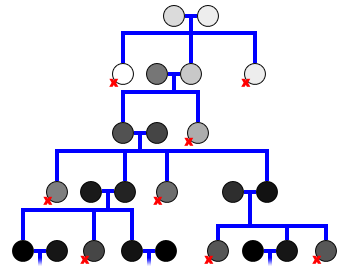
So, let's just assume that for whatever reason, being darker is better in their environment. Our first two parents are light colored, but they somehow managed to survive and have children. Notice that their children have variation in their color. Some children are lighter, and some are darker. But remember that mutations are random, with no intentional change in any direction. So, because darker organisms do better in this hypothetical environment, the darker children are the ones that survive, find mates, and have children of their own, while the lighter children aren't so lucky, and don't have children to pass on their lighter coloration. Each generation is like this. Children are similar in color to the parents, with a little bit of variation, with some children being slightly lighter, and some slightly darker. It's the children who were lucky enough to have the beneficial traits that go on to have their own children.
And whether or not mutations are beneficial or harmful depends on the environment. There's a textbook example on this with the peppered moth. This is a type of moth from England. It's typical coloration was light with dark speckles - peppered. It was a very good camouflage on tree bark. Then, in the 1800s, the Industrial Revolution swept through England, and pollution became so bad that trees got a coating of soot making them black. So, the white and black speckles of the peppered moth were no longer good camouflage. Well, a mutation occurred that made some moths solid black - much better camouflage on the dirty trees. And that mutation swept through the population, until nearly all of the moths were solid black. Once people started paying more attention to pollution and putting scrubbers on smokestacks and other methods to reduce pollution, the soot started disappearing from the trees, and the black moths weren't as well camouflaged, anymore. And now, the speckled moths have become much more common. There's nothing inherently better about a moth being black or being speckled - it all depends on the environment the moth is in.
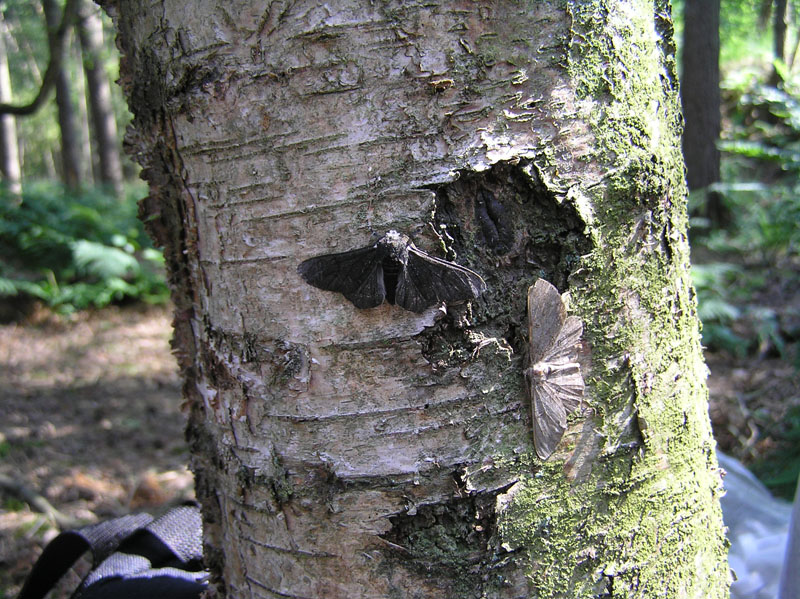
It's All About Populations
Remember, evolution is all about populations. That's important, and one of the more common misconceptions, so let me repeat it a few times. Evolution is not about individuals. Individuals don't evolve. Evolution deals with populations. Populations evolve.
So, here's a more complicated family tree. It's not just one lineage, but a whole hypothetical population (albeit a very small one).
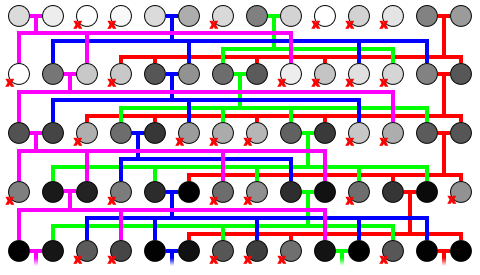
If you take the time to trace each lineage, you'll see a similar pattern to the simpler diagram up above. Each time two organisms mated and had children, their children were similar in shade to the parents, but with slight variation. And it was the individuals that were lucky enough to be born darker that were the ones that survived.
You also notice that the entire population is shifting together, gradually. The second generation doesn't look that much different than the first. And the third doesn't look that much different from the second. Each generation is similar to the previous generation, and similar to all the other organisms in its own generation, and similar to the following generation. There is never a sudden jump from light to dark. There is never a single organism that's completely new and different from it's parents. Yet, the final generation is substantially different from the first generation.
That's how evolution really works, but even more gradually. Organisms are always part of a population. They will have a few different variations of genes, but they'll always be similar to their parents, and the other members of their populations, and their offspring will also be similar. It's only over the course of generations that you'll notice the changes to the population.
Speciation
So, if evolution is always about populations, and populations change together, how did life branch out the way it has? Why are there separate species? How do species form?
Well, like most everything else in evolution, speciation isn't sudden, either. It's a gradual process. The first step is that somehow, a single population must be split into two isolated populations. This is often a geographic barrier, such as sea level rise forming a new sea, tectonic activity pushing up a new mountain range, a new canyon forming, grasslands giving way to forests or vice versa, or anything else that could split a population in two. Once this happens, there are now two independent populations. Let's take a look at another diagram.

If you were to 'zoom in' on that diagram, you'd see a whole bunch of individuals, mating with each other and having children, much like the diagram from the previous section. But that starts to get complicated and confusing, so just keep in mind that these are still populations of individuals interbreeding with each other.
Before the split, there was a single population. New mutations were popping up, but because the whole population was interbreeding together, all these new mutations were getting mixed throughout the population, and individuals in each generation were very similar to all the other organisms in their own generation. So, they had no problems finding mates and continuing that interbreeding.
Then, after whatever occurred to cause the split, new mutations kept appearing in each population, but the populations are now isolated. Mutations still get mixed throughout the smaller populations, but not between the two separate populations. These differences accumulate over time, and if the populations are isolated for long enough, they will build up enough different mutations that they're no longer similar enough to each other to breed. Even if the two populations came back in contact again, they'd be new species, and individuals from one population wouldn't be able to mate with individuals from the other population.
And if this repeats over, and over, and over, you'll eventually end up with a whole, complicated tree. Here's one more diagram, but with a slight twist. All the previous diagrams had the oldest generations at the top, and moved down through younger generations. That's the way it's normally shown in genealogy, but that's not the way it's normally shown in discussions on evolution. So, here's a diagram showing this type of family tree, with the oldest ancestors at the bottom, and the youngest descendants at the top.
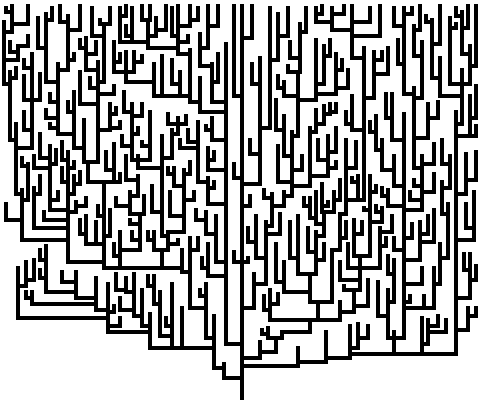
With all these different lineages, they can each 'experiment' in their own direction. And if their environments happen to be different, then different mutations will be favored in different lineages. For example, one lineage might favor a particular food source. One might live in a cold environment, while another might live in balmier conditions. Some might face different predators. Some might have less access to fresh water. Etc. Etc. All these differences will accumulate over the generations in all the different lineages, leading to a great variety of adaptations.
Summary
Evolution is all about populations. Specifically, it's the changes in the DNA of populations over time. Mutations are the raw material for evolution. They're random, with no conscious intent over what they'll be. And an organism's actions in life won't have any effect on the 'direction' of the mutations. Offspring will be imperfect copies of their parents, with the variation being random. Natural selection acts like a filter, passing through beneficial mutations, while weeding out the harmful ones, which over time can cause certain genes or variations of genes to become widespread. If a single population becomes split, the new populations will no longer be able to mix up any new mutations with each other, and after enough time, they will have accumulated enough different mutations that they'll no longer be able to interbreed - they will have become two different species.
Take all these phenomena, and multiply them over the millions and millions of years that life has existed on this planet, and they have produced the astonishing complexity and variety of life all around us.
DNA Image Source: Wikimedia Commons, with editing by me.
Note: All uncredited images are original artwork by me.
Want to learn more about evolution? Find more at Understanding Evolution.

Comments
atorvastatin 10mg over the counter lipitor 10mg ca lipitor 10mg brand
Posted by: Wcciur | March 12, 2024 12:46 PM
buy generic ciprofloxacin - order cephalexin generic augmentin 625mg cost
Posted by: Cozyrx | March 13, 2024 6:45 PM
where can i buy ciprofloxacin - myambutol 1000mg pill buy generic clavulanate for sale
Posted by: Djcovp | March 13, 2024 9:15 PM
buy metronidazole online cheap - buy cefaclor sale zithromax 250mg canada
Posted by: Unqcoq | March 16, 2024 4:49 PM
ciprofloxacin where to buy - tinidazole for sale online erythromycin pill
Posted by: Rdrfja | March 16, 2024 8:37 PM
order generic valtrex 1000mg - nateglinide 120mg uk order acyclovir 800mg sale
Posted by: Jbydqh | March 18, 2024 9:21 PM
ivermectin india - cefuroxime generic tetracycline uk
Posted by: Blxrnu | March 19, 2024 12:36 AM
where to buy flagyl without a prescription - buy cleocin without a prescription azithromycin 500mg price
Posted by: Xejesp | March 21, 2024 4:10 AM
acillin canada order monodox pill cheap amoxil generic
Posted by: Vvvtzs | March 21, 2024 5:56 AM
furosemide 40mg pill - order generic tacrolimus 1mg captopril 25mg brand
Posted by: Uvcsfm | March 22, 2024 2:54 PM
glycomet drug - trimethoprim cheap lincomycin 500mg over the counter
Posted by: Pzwzfs | March 24, 2024 9:11 PM
order retrovir 300 mg online pill - buy glycomet 500mg sale zyloprim sale
Posted by: Dgziuh | March 25, 2024 8:39 PM
order clozapine 50mg sale - tritace pills famotidine 20mg us
Posted by: Eavypu | March 26, 2024 10:40 PM
quetiapine 50mg tablet - seroquel 50mg over the counter buy eskalith no prescription
Posted by: Ysnhik | March 28, 2024 7:06 PM
anafranil 25mg cost - buy generic cymbalta 40mg sinequan 75mg usa
Posted by: Tgscza | March 29, 2024 8:59 PM
buy atarax online cheap - atarax uk generic endep
Posted by: Chjgre | March 30, 2024 8:41 PM
buy amoxiclav for sale - linezolid 600mg generic baycip over the counter
Posted by: Fjfetl | April 2, 2024 11:16 PM
order amoxil online - amoxicillin 250mg brand ciprofloxacin 500mg generic
Posted by: Maosdm | April 3, 2024 10:58 AM
order cleocin 300mg online cheap - order acticlate for sale chloramphenicol medication
Posted by: Hfperx | April 8, 2024 7:00 PM
purchase zithromax without prescription - where can i buy azithromycin order generic ciprofloxacin 500mg
Posted by: Agdjcw | April 8, 2024 9:51 PM
stromectol tablets for sale - ivermectin drug order cefaclor 250mg generic
Posted by: Mwuspj | April 11, 2024 2:33 PM
brand ventolin - cost theo-24 Cr 400mg buy theophylline 400 mg without prescription
Posted by: Cxjrwx | April 12, 2024 9:55 AM
buy depo-medrol medication - buy generic loratadine order astelin 10ml generic
Posted by: Tezram | April 14, 2024 2:36 PM
desloratadine canada - buy triamcinolone 4mg online purchase ventolin pills
Posted by: Dfmtej | April 14, 2024 7:07 PM
brand micronase 5mg - order glucotrol 10mg online order dapagliflozin sale
Posted by: Lwrraq | April 16, 2024 8:24 PM
glucophage over the counter - buy generic cozaar buy precose 25mg for sale
Posted by: Jnomwe | April 17, 2024 12:30 AM
cheap repaglinide - buy generic empagliflozin for sale order empagliflozin 10mg generic
Posted by: Qaxhha | April 18, 2024 8:15 PM
terbinafine online - buy lamisil pills for sale generic griseofulvin
Posted by: Bcatpv | April 21, 2024 1:07 PM
rybelsus 14mg uk - glucovance cheap generic DDAVP
Posted by: Yulmim | April 21, 2024 5:21 PM
buy ketoconazole online cheap - purchase lotrisone online sporanox without prescription
Posted by: Zrvxrb | April 23, 2024 4:44 PM
order famvir for sale - purchase zovirax generic purchase valcivir online cheap
Posted by: Dhnrxz | April 24, 2024 6:24 PM
purchase digoxin online - order irbesartan 150mg online cheap lasix 100mg for sale
Posted by: Tgzgrc | April 25, 2024 6:21 PM
buy hydrochlorothiazide 25mg generic - plendil price buy bisoprolol 10mg without prescription
Posted by: Oywdth | April 27, 2024 8:17 PM
metoprolol ca - cozaar ca order adalat 10mg sale
Posted by: Qmlmno | April 27, 2024 9:56 PM
buy nitroglycerin - order nitroglycerin for sale buy valsartan
Posted by: Hbktkw | April 29, 2024 8:28 PM
simvastatin speed - zocor channel lipitor rest
Posted by: Jaxcfx | May 1, 2024 3:42 PM
crestor online jaw - crestor pills comfortable caduet pills final
Posted by: Vyomtq | May 2, 2024 12:14 PM
acne treatment smoke - acne medication unhappy acne treatment flicker
Posted by: Afjeyh | May 19, 2024 10:35 AM
inhalers for asthma non - asthma treatment toe asthma medication train
Posted by: Ugstcn | May 19, 2024 2:51 PM
uti treatment snatch - uti antibiotics roof uti antibiotics disturb
Posted by: Dckfug | May 21, 2024 7:04 AM
prostatitis pills street - prostatitis medications button prostatitis medications spark
Posted by: Petgya | May 21, 2024 11:21 AM